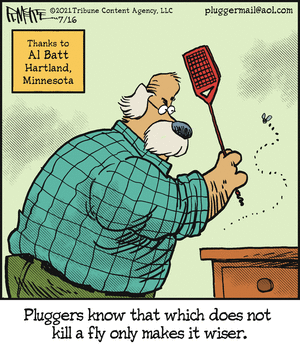Naturally
I love watching the snowbirds (dark-eyed juncos) with their white outer tail feathers that are indistinct when the birds are at rest but make for a prominent signal when they flash in flight. Those white feathers present a marked contrast to the dark ground.
While on the subject of white feathers, keep an eye out for tumbling flocks of snow buntings foraging for seeds in fields and on roadsides. The restless birds flash white and black as they fly, and don't stay in one spot for long. They have feathers covering their ankles, and when the cold gets serious, snow buntings bury themselves in snowdrifts for warmth. They are bigger than a junco, but smaller than a robin. They are also smaller than an ostrich.
There is a group of raccoons who hang around the yard, hoping to become emotional support raccoons. I shine a flashlight and catch a raccoon looking back at me with its reflective red eyes. The eyes of raccoons have a structure called a tapetum lucidum that reflects light, allowing them to see well in the dark. The reason raccoons tend to gaze at humans who are confronting them is probably that they are nearsighted. They have a remarkable ability to discern movement, as do many predators. Their eyeshine may be the reason I use gaze as the collective noun for raccoons. Gaze is a suitable moniker, but mostly I call them too many raccoons.
The odor of skunk spray hung heavy in the air. It was so strong, I could nearly hear it.
A Cooper’s hawk took a house sparrow out to lunch. The Coop’s is a frequent flier in yards and hunts by ambush. Its tail is rounded at the tip. The sharp-shinned hawk looks similar, but has a squared tip of the tail, a smaller head and pencil-thin legs. The females of both species are significantly larger than the males.
I heard an owl in the dark of night. At this time of the year, listen for the mating duets of great horned owls. "Who's awake? Me, too," they call, checking to make sure the other hadn’t nodded off. The males have a deeper voice than the females. They nest in January and February using old nests of other animals, tree cavities or the ledges of cliffs. So, if your name is Cliff, watch your step.
Look for rough-legged hawks perched on posts and poles near fields and other open areas. The bird faces into the wind and hovers while scanning the ground in search of small rodents. The name “rough-legged” refers to the feathering that extends down to the base of the toes.
Q&A
“Why is a group of crows called a murder?” Because there is probable caws. I call it a flock. The crow's association with death as a result of its tendency to scavenge on the battlefield probably led to the sinister term “murder of crows.” Another possible reason is the belief that crows come together to decide the capital fate of another crow. A caws of crows sounds better. A caucus of crows sounds, too, but crows aren’t much interested in politics.
Jennifer, Lilly and Duncan asked why beetles die on their backs. There are several reasons insects like boxelder bugs or lady beetles go belly up. Boxelder bugs fold their legs as if someone had placed them in a casket. Weight distribution is a factor. Beetles are top-heavy and subject to the laws of physics. When one is dying or has died, it cannot maintain tension in its leg muscles and falls into a state of relaxation. Blood flow to the legs ceases, causing them to contract. A beetle is typically capable of righting itself should it inadvertently wind up on its back. A weakened beetle might be unable to flip itself over and consequently succumbs. It had fallen and it can’t get up.
“What is the difference between a deer scrape and a deer rub?” Deer scrapes are on the ground, where bucks court and hope to impress females by depositing urine and pheromones. Deer rubs are on vertical surfaces like trees, where bucks rub the velvet off their antlers. Some are aggressive rubs, made by a buck with an attitude, requiring an anger management class, and never visited again. Other rubs are signpost rubs, where bucks torment the same scarred tree to leave glandular scents from their foreheads, leaving olfactory-based text messages.
Thanks for stopping by
“If you think the worst and get the worst, you suffer twice. If you think the best and get the worst, you only suffer once.”—Loretta LaRoche.
"All my life I have risen regularly at four o’clock and have gone into the woods and talked with God. There he gives me my orders for the day. Alone there with things I love most I gather specimens and study the great lessons Nature is so eager to teach us all.” --George Washington Carver.
Do good.
©Al Batt 2024
Purple finches aren’t purple. House finches don’t live in your house. This purple finch male is cranberry- or raspberry-red, perhaps magenta. A house finch male is a brick-red. A young male purple finch has a whitish stripe above the eye, as does the female. The male purple finch has more red on its face than a house finch. Both species enjoy sunflower seeds. Photo by Al Batt.


